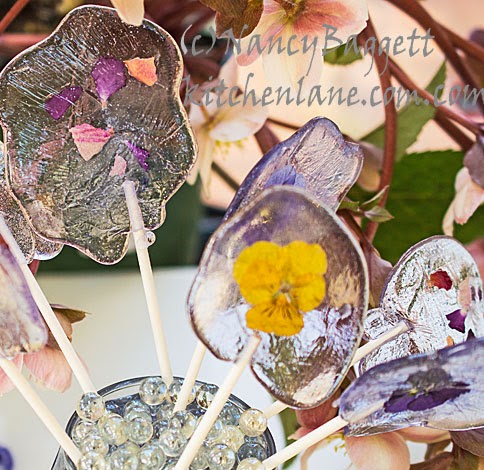
| Violet and Pansy Lollipops |
Author: Nancy Baggett
You’ll need a candy thermometer for this recipe. The other special items required are the lollipop sticks. And, of course, you do need the edible, organically grown flowers, which can include pansies, roses, pinks, and wild woodland violets. (Note that African violet houseplants are not the same as wild violets and are not edible.)
Lollipop sticks are usually stocked in the cake and pastry decorating sections of discount department stores and in some craft stores or kitchen shops. In a pinch, use wooden Popsicle sticks instead—the lollipops won’t look quite as elegant, but kids never care! Also, expect the pops to come out in natural free-form shapes rather than perfectly round. Even on a tray with a perfectly flat surface, the molten syrup tends to run out unevenly. But the randomness just contributes to the charming homemade look.
There is one important caveat to always remember when making these lollipops or any other hard candy: The boiling sugar mixture is extremely hot. Never try to touch it or taste it while cooking or pouring. And take care never to splash it on your skin. If it drips on the counter top or stove, wipe it off with a wet, warm cloth, never your hand. If you have it, use a heavy cooking pot with a lip for pouring. This will facilitate pouring the molten candy from the pot.
Lollipop sticks are usually stocked in the cake and pastry decorating sections of discount department stores and in some craft stores or kitchen shops. In a pinch, use wooden Popsicle sticks instead—the lollipops won’t look quite as elegant, but kids never care! Also, expect the pops to come out in natural free-form shapes rather than perfectly round. Even on a tray with a perfectly flat surface, the molten syrup tends to run out unevenly. But the randomness just contributes to the charming homemade look.
There is one important caveat to always remember when making these lollipops or any other hard candy: The boiling sugar mixture is extremely hot. Never try to touch it or taste it while cooking or pouring. And take care never to splash it on your skin. If it drips on the counter top or stove, wipe it off with a wet, warm cloth, never your hand. If you have it, use a heavy cooking pot with a lip for pouring. This will facilitate pouring the molten candy from the pot.
Ingredients
- Assorted small edible flowers and petals, such as organic pansies, roses, or woodland violets
- 1⅓ cups granulated sugar
- ⅓ cup light corn syrup
- ⅓ cup warm water
- ¼ teaspoon raspberry extract, rose extract, or lemon extract
- Drops of botanical food dye, optional
Instructions
- Ready the flowers or petals by gently but thoroughly washing and patting them dry. Flatten by placing them between triple thicknesses of paper towels, then weighting them down under a heavy book or stack of books overnight or longer. Very gently peel them from the paper before using.
- Set out a 2-cup heat-proof glass measure. Set out a very large flat tray or baking sheet (or 2 smaller sheets) and line with heavy-duty foil. Place 12 to 15 lollipop sticks on the foil, spacing to allow for the candy to spread out to at least 2½ inches in diameter and preferably more. Place the flowers or petals attractively around the top end of the sticks. Set out a heat-proof bowl of ice water.
- In a heavy medium-sized saucepan thoroughly stir together the sugar, corn syrup, and water. Bring the mixture to a boil over medium-high heat, stirring. Cover the pot and let the trapped steam wash any sugar crystals from the pot sides for 2 minutes; lift up the pot from the heat and swirl the mixture several times. Remove the lid. With a wet pastry brush or damp paper towel, wipe away any sugar crystals clinging to the pan sides.
- Continue cooking, never stirring, but lifting and swirling the pan to redistribute the syrup every minute or so. When the syrup has boiled down about 5 minutes, start checking with the candy thermometer. As soon as the syrup registers 305 degrees F, immediately remove the pot from the heat. Quickly add the extract and drops of botanical dye (if using) and swirl the pan until blended in fairly well. Immediately set the pan in the bowl of ice water to stop the cooking and lower the temperature; let stand for 5 minutes, lifting and swirling the pan several times.
- Carefully turn out the cooling syrup into the 2-cup measure. Start forming the lollipops by pouring the syrup over the center tops of the lollipop sticks; sure not to touch the mixture. Continue at a steady pace until all the pops are formed. If at any point the syrup cools and stiffens too much to pour, place the measure in the microwave oven and reheat the mixture for 5 to 10 seconds, or until it is just fluid again. Don’t try to scrape out any left in the cup, as it may turn gritty and cloudy.
- When all the pops are done, slide the baking sheet into a refrigerator and let the candies cool and chill thoroughly. Then, gently peel each one from the foil as needed. Wrap them individually in non-stick clear plastic wrap or special hard candy wrappers. Stored in a cool dry spot, they will keep for several months.
Recipe by KitchenLane at https://kitchenlane.com/2015/03/violet-and-pansy-flower-lollipops.html